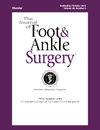评价透视在跟骨钉置入中的作用。
IF 1.3
4区 医学
Q2 Medicine
引用次数: 0
摘要
虽然文献中提倡透视辅助跟针置入踝关节外固定或骨骼牵引,但缺乏透视的必要性证据。本研究旨在比较在有和没有透视指导下进行跟骨钉置入的患者的跟骨钉位置和并发症。在这项回顾性队列研究中,纳入了2022年10月至2024年5月期间接受踝关节骨折外固定的成年患者。主要结果是在安全区域内的球钉率。次要结果为针距内踝尖端及跟骨最后方点的距离及神经血管缺损、跟骨骨折等并发症。82例患者(平均年龄47±16.4分钟)。89例(54.9%为男性)参与了这项研究。45例患者(第一组)在没有透视辅助的情况下放置针,37例患者(第二组)在透视辅助下放置针。1组5例患者(11.1%)、2组7例患者(18.9%)将针置于安全区外(P = 0.320)。1组距内踝平均38.8±7.9 mm, 2组距内踝平均51.3±8.32 mm (P < 0.001); 1组距跟骨最后方平均25.2±6.3 mm, 2组距跟骨最后方平均21.4±7.9 mm (P = 0.019)。随访期间未见神经血管并发症及跟骨骨折。综上所述,透视指导并不能为植入跟骨钉提供任何额外的好处。本文章由计算机程序翻译,如有差异,请以英文原文为准。
Evaluating the role of fluoroscopy in calcaneal pin placement
Although fluoroscopy-assisted calcaneal pin placement for ankle-spanning external fixation or skeletal traction was advocated in the literature, evidence for necessity of fluoroscopy for this application is lacking. This study aimed to compare the calcaneal pin locations and complications of patients who underwent pin placement with and without fluoroscopy guidance. In this retrospective cohort study, adult patients that underwent external fixation for ankle fractures between October 2022 and May 2024 were included. The primary outcome was the rate of the pins that were inside the safe zone. Secondary outcomes were the distance of pins to the tip of medial malleolus and the posteriormost point of calcaneus and complications such as neurovascular deficit and calcaneal fracture. Eighty-two patients (mean age 47±16.4 - min. 18 - max. 89, 54.9 % male) were involved in the study. Forty-five patients (group 1) had their pins placed without fluoroscopy assistance and thirty-seven patients (group 2) with fluoroscopy assistance. Five patients (11.1 %) in group 1 and seven patients (18.9 %) in group 2 had their pins placed outside the safe zone (P = 0.320). Distance of the hole from medial malleolus was mean 38.8 ± 7.9 mm for group 1 and 51.3 ± 8.32 mm for group 2 (P < 0.001), and distance from posteriormost point of calcaneus was mean 25.2 ± 6.3 mm for group 1 and 21.4 ± 7.9 mm for group 2 (P = 0.019). No neurovascular complications or calcaneal fracture were seen during follow-up. In conclusion, fluoroscopy guidance does not provide any additional benefit for placing calcaneal pins.
求助全文
通过发布文献求助,成功后即可免费获取论文全文。
去求助
来源期刊

Journal of Foot & Ankle Surgery
ORTHOPEDICS-SURGERY
CiteScore
2.30
自引率
7.70%
发文量
234
审稿时长
29.8 weeks
期刊介绍:
The Journal of Foot & Ankle Surgery is the leading source for original, clinically-focused articles on the surgical and medical management of the foot and ankle. Each bi-monthly, peer-reviewed issue addresses relevant topics to the profession, such as: adult reconstruction of the forefoot; adult reconstruction of the hindfoot and ankle; diabetes; medicine/rheumatology; pediatrics; research; sports medicine; trauma; and tumors.
 求助内容:
求助内容: 应助结果提醒方式:
应助结果提醒方式:


